Hand-rearing barbets, Megalaimidae sp.
Devna Arora
Asian barbets
There are 28 recognized species of Asian barbets: 26 species of typical barbets (megalaima) in the family Megalaimidae, along two separate genuses that include the Brown and the Fire-tufted barbet. The birds all inhabit wooded areas preferring broad-leaved trees. An exception to this is the Coppersmith barbet (Megalaima haemacephala), also prefers broad-leaved trees but readily lives and breeds in rural and suburban landscapes.
Asian barbets are known to consume fruits that they can swallow whole – primarily figs and other berries. Some species are also known to thrive in plantations. The birds also consume various insects and grubs, while larger birds may opportunistically pick up small lizards and frogs as well – this behaviour seems to be strongly associated with the high amounts of protein required to feed the young during the breeding period.
Asian barbets are known to breed between the summer months of Feb and August, laying a clutch of 2-4 eggs and may raise more than 1 brood of chicks in the season. Nests are made in cavities of dense trees and may easily be over a foot deep. The eggs are actively incubated by both parents and are known to hatch after an incubation period of 2-3 weeks depending upon the species. Chicks are actively fed by both parents and they fledge at the age of about 28-35 days on average. Fledgling chicks are dependent on their parents for at least a few weeks after they fledge and are continued to be fed by the parents until they are independent.
Need for assistance
Baby barbets are not commonly admitted as rescues. Their nests are made in tree cavities and therefore highly unlikely to fall. The primarily reason for admitting the species is when nesting trees have been felled during the nesting season. Such rescued babies may be placed in artificial nests (use similar dimensions as those of boxes described in pg. 5) and hung close to their original nesting trees; observe the nest from a distance to make sure the parents have returned to the new nest and have started feeding the chicks. Parent barbets frequently completely abandon such spaces once the nesting trees have been felled, making it necessary for the babies to be hand-raised.
The chicks may also be found during the fledgling stage when they either jump out of the nest too soon or are unable to keep up and land in unsafe locations. In most cases, the parents will be close-by, keeping an eye on the chicks and feeding them wherever they are, thus requiring no human intervention. Ensure, from a safe distance away so as not to scare away the parents, that the chicks have been unfed or unattended to for at least a few hours before attempting to rescue the chicks.
Identifying and sexing barbets
Asian barbets are small green birds with often striking colouring around the face, crown and bib. They have heavy beaks (proportionately bigger in the larger species) with large, prominent and outward pointing bristles around the base of the beak. Depending on the species, the distinct eye rings and throat patches will also visible once the birds are feathered.
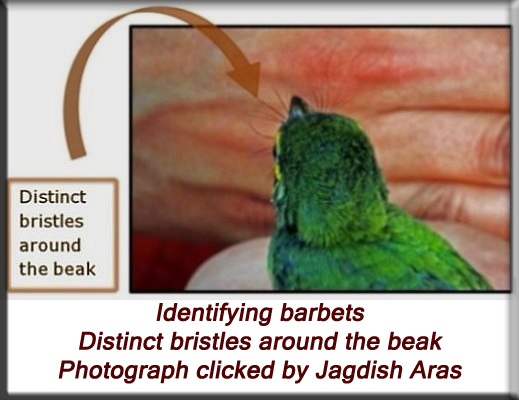
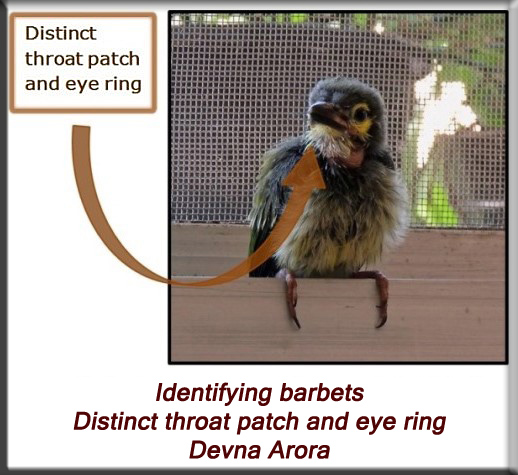
Male and female barbets are monomorphic, i.e., there is no external distinguishing factor between the male and the female, but the females may have duller plumage in comparison to the males of the species. Females also have comparatively lighter (often dullish red-brown) coloured bills while the bill of male birds is black.
General guidelines for hand-rearing barbets
Hygiene
The chicks must be kept in extremely hygienic conditions until they are ready to fledge as young chicks are susceptible infections. Their bedding must be kept clean and changed as often as required. Hands must be washed every single time before touching the nestlings. Excessive handling of the chicks must be avoided and they must only be handled during feeding times, although in most cases, it will be absolutely unnecessary to touch the chicks when feeding them.
Chicks will defecate several times through the day. Baby bird droppings are often enclosed in a capsule-like structure which makes it very easy for the parent birds to pick and drop them away from the nest. In most cases, you should be able to do the same and the paper towel lining may only be replaced a couple of times a day. But if you are unable to pick the droppings, then the towel must be replaced each time the chick defecates to prevent the droppings from sticking to the chick’s feathers and skin. Droppings harden after sticking to the body and are extremely painful to remove and inevitably peel off with a bit of skin, exposing raw skin to bacterial infections.
Baby barbets can be a little messy and a rather slow on preening until after fledging. Although they do judiciously preen their feathers and remove the casings of the pin feathers, they are unlikely to try and clean their beak or feathers of any food residue. They must therefore be wiped clean promptly after feeding them. Food residue left on then will again harden and stick to the body inviting bacterial infections and fungal growth – this must be avoided.
Handling and lifting barbet chicks
Unlike most birds, barbet chicks move by moving backwards, and they often keep backing until they can feel something solid against their backs. Freshly rescued birds will be particularly shy and will back away suddenly and quickly. Never leave them unattended on a table as they will most likely back up and fall off. If lifting or carrying them, ensure to always hold them in cupped hands.
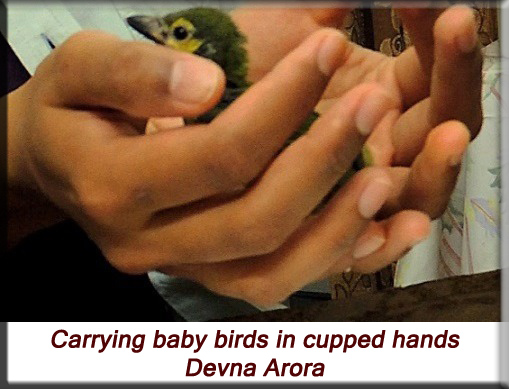
Alternatively, what I found effective for nestlings (although, I would recommend carrying them in cupped hands rather than this) was to lift them by inserting two fingers under their chest and lifting their body, leaving the legs hanging. Fledglings may be carried like normal birds – they will even perch on your hands although it is best (for their survival after release) not to train them to do so.
Housing
The chicks must be housed indoors in small nesting boxes. Although, smaller boxes: 10 x 15 cms width and 20 cms deep are adequate for nestlings, I find it comfortable to house them in slightly larger boxes: 20 x 20 cms width and 25 cms deep as it is easier to feed the chicks in the larger boxes itself and they are easier to keep clean.
The chicks must never be placed on the cloth towels directly as their nails tend to get caught in the fibrous loops of the towels. Cotton too must never be used to line the nests as it gets entangled around the chick’s beak and claws and also sticks to the droppings. The chicks must instead be placed on paper towels upon the cloth towel which also makes it easier to clean and replace soiled bedding.
On fledging, the chicks must be shifted to an aviary for adequate flight exercise before release. An aviary that is roughly 10 ft. X 5 ft. and 8-10 feet high is adequate for barbet chicks. The aviary must be equipped with several perches and some foliage but must also allow the barbets to fly about freely and exercise their fight muscles.
Inter-species interactions
The chicks must never be house in close proximity to predatory species like crows, hawks, cats or dogs. Housing the chicks in close proximity to such species will either lead to constant stress due to the smells, sounds and movements of the predators; or it will lead to habituation and lack of fear and decrease their chances of survival after release.
Imprinting and dependency
Imprinting is a process whereby a young animal learns and imitates the behaviour traits of its parents. It serves as an indirect method of instilling the appropriate behaviour and survival traits in young animals.
Under the unnatural conditions of captivity, the chicks may imprint on humans and other animals they are constantly exposed to. To prevent this, they must never be handled excessively or exposed to too many people and animals, and handling must cease once the chicks have fledged. This also keeps them from being dependent on the caregivers.
Warmth
Birds, especially smaller sized birds, have higher basal metabolic rates and higher body temperatures ranging between 39˚C – 43˚C (102˚F – 107˚F). New-born chicks require additional warmth to maintain their body temperatures in the initial weeks of their lives and must always feel slightly warm on touch. As a rule of thumb, the smaller the chick, the more warmth it will require. Unfeathered chicks will require external heat all day long. The intensity of heat required will gradually reduce as the chicks become adequately feathered and discontinued upon fledging.
External heat may be provided in the form of incubators, heating lamps or hot-water bottles. Most breeding and rescue centres are equipped with incubators and prefer the same for baby birds. It is easiest to both control and monitor the temperature of the nest chamber when using incubators. But these may not be easily available to individual rescuers, in which case, alternate methods of providing external heat may be used. A primary advantage of summer breeders is that they nest during the warmer months of the year and the chicks require little additional heat when kept at room temperatures.
Heating lamps adequately serve the purpose of providing heat for nestlings. The distance of the heating lamp from the box will depend upon the wattage of the bulb and the body condition of the chicks. A room thermometer placed in the box will help you gauge the temperature and adjust the distance of lamp as and when required. Chicks that get too warm will pant to decrease their body temperature. If such behaviour is noticed, external heat must be reduced and ventilation increased immediately to prevent over-heating. The box must be covered with a cloth at night to prevent the light of the lamp from falling directly on the chicks and interrupting the natural circadian rhythm of the chicks.
Hot-water bottles may also be used for the chicks and are safe to use with smaller birds. The bottle, wrapped in a couple of layers of cloth, must be placed under the chick’s bedding and it must be ensured that the chicks cannot come in direct contact with the bottle as they will scald if they do. Hot-water bottles must only be placed under half of the chick’s bedding leaving them the flexibility to shift to the uncovered part of the box if they get too warm. Hot-water bottles may even be placed just outside the box while still touching the box to ensure adequate warmth.
Water and hydration
Baby birds are seldom given water orally. They receive adequate water through their feeds. Baby birds must be offered soft and moist foods as it both assists digestion and ensures sufficient hydration. Mild dehydration may be addressed by offering the chick softer foods or formulas until dehydration has been addressed. To help restore the electrolyte balance in dehydrated chicks, rehydration electrolytes may be added to the formula. Refrain from administering water orally as the risk of water going down the trachea and aspirating the chick is high. If severe dehydration exists, the chick may be given fluids subcutaneously but this must only be done by an avian veterinarian. Such chicks must be fed only after dehydration has been addressed.
Baby birds that are dehydrated will appear weak and listless. Their skin, especially around the breast and stomach, will appear tighter and wrinkled. The skin turgor test or the ‘tent test’ may also be used to assess dehydration. Well hydrated chicks, on the other hand, are soft to touch and appear rounded and well. They will also be a lot more active and interested in movements around them than dehydrated chicks.
Feed and formulas
The chicks need to be fed every half hour for the first two weeks of their life, and then every hour to every hour and a half until they fledge. Feeding must begin at dawn and continue for the next 12 hours or so until sunset. If feeding several chicks, you must ensure that all chicks are well fed as the runts or weaker chicks often get pushed aside and may consequently get weaker if not given adequate attention.
Baby barbets can be comfortably hand-raised on fruits like banana, chiku (sapodilla), muskmelon and fig. Protein must be provided in the form of boiled eggs, fish, caviar or caterpillars. Different feed combinations will be appropriate for the chicks at different stages of their growth and development – details given in ‘stage-wise care’ after page 18.
Foods to be offered
• Banana – excellent base food for the formula – nutritious and easily digestible. 50% of the chick’s diet can comprise of banana during the hand-feeding stage.
• Figs – excellent feed and closest to the adult’s natural diet. Young chicks though are not often fed on figs but rather various berries. Proportion of figs may be up to 20% of diet in unfeathered chicks, increasing to 50-80% of diet in fledglings.
• Chiku (Sapodilla) – a good addition to the diet – upto 20% of a feathered chick’s diet can comprise of chiku.
• Muskmelon – excellent and easily digestible, although quite high in water content for nestling birds. Again, an excellent option if rehydrating chicks. Feed proportion can be kept to 20-30% of diet.
• Boiled eggs (both egg yolk and white) – excellent feed option – good source of protein and high in natural fats and minerals. Can comprise of roughly 50% of diet in unfeathered chicks; 20-25% of diet in feathered chicks and completely stopped once the chicks have fledged. Use higher ratio of egg yolk for unfeathered chicks.
• Soft boiled fish – a good feed option – a source of easily digestible protein, fats and vitamins. Can comprise 20% of the chick’s diet.
• Soft boiled caviar (fish eggs) – another excellent feed option – good source of protein and unlike eggs (chicken’s), it is given whole – making a better substitute for the invertebrate protein which the parents would provide in nature. Can and must comprise of roughly 50% of diet in unfeathered chicks; 20-25% of diet in feathered chicks and completely stopped once the chicks have fledged.
• Infant cereals – cereals without any milk, for example, Nestum, may be added to the chick’s diet. Although the chicks digest it well, it is an unnatural and unnecessary addition to their diet but may be used for convenience. Do not use infant formulas that contain milk.
Foods that may be offered judiciously
• Grapes – very high in water content and not a good feed option for the chicks. But using fresh squeezed grape juice instead of water to dilute the feeds is a great idea – a good way to provide natural sugars and vitamins.
• Pomegranate – I wouldn’t recommend serving pomegranates to the chicks because of the seeds. But using fresh squeezed pomegranate juice instead of water to dilute the feeds is again a great idea – a good way to provide natural sugars and vitamins.
• Guava – may be offered in small quantities, not exceeding 10% of daily diet. Avoid the seeds.
• Caterpillars and other grubs/larvae – a good, natural source of protein and, if feasible, may be added to the chick’s diet. They may be wild caught but the easiest way to obtain caterpillars is by combing through rotten vegetables like cauliflowers and peas. They must nonetheless be picked carefully as some species can be poisonous and harmful for young birds.
• Grasshoppers, crickets, dried fish and shrimp too may be chopped and added to the chick’s diet, although I have not personally tried these food items and therefore advise you to do so judiciously.
Foods to be avoided
• Papaya – I would advise you not to use papaya for the chicks at all. I tried papaya at different stages twice and had severe reactions with Coppersmith barbet chicks each time. The 1st attempt was at 3 weeks of age – one chick immediately vomited half the papaya, both had diarrhoea and completely fell low within an hour after serving the fruit. The 2nd attempt was at 1 month of age, after fledging – again, both chicks had severe diarrhoea immediately. Both times, the condition was corrected by administering anti-diarrhoeal medications, and glucose and electrolytes to stabilize the chicks. The chicks responded well to the treatment each time.
Papaya may be given to older birds, but in my limited experience, must not exceed 10-15% of their daily diet. The birds are strongly attracted to the colour of papayas and tend to selectively overeat it as well which also leads to excessive droppings if not diarrhoea.
• Mango – unlike papaya, the chicks did not seem to be attracted to mangos at all and are therefore unlikely to consume it if given the choice. Again, it must not exceed 10-15% of their daily diet.
Avian vitamins and calcium supplements must be added to the formula for baby birds. The next best choice to avian supplements (if none available) would be other veterinary or paediatric vitamin drops – choose a supplement with added minerals too. Most multivitamin combinations do not include calcium and this must be supplemented as well – veterinary calcium drops are a good option. Probiotics too may be added to the chick’s diet. Avian probiotics are of course the first choice but human or veterinary probiotics, for example, Gutwell, too will be helpful. The exact doses may be obtained from an avian veterinarian.
Baby birds will be given a formula consisting of pureed fruit and fish/eggs. It is easiest to feed them with a syringe for the first 2-3 weeks of their life. Once the birds are nearing fledging age, they can be fed small boluses of mashed fruit and egg/fish either by hand or with a pair of forceps. Fledglings will comfortably takes pieces of fruit with a pair of forceps and will soon pick up pieces of fruit from a plate.
The consistency of the formula should be similar to that of a soft pudding – neither too thick, which would make it difficult for the baby to swallow and it may choke, nor too diluted as the baby could inhale the formula into its lungs causing aspiration. The chicks must be fed warm formula just as mammalian young are given warm milk. Formula that is too hot will scald the baby bird’s crop, causing crop burn. Crop burn is the scalding of the chick’s crop and oesophagus. Cold formula, on the other hand, will slow the process of digestion and cause ‘sour crop’. Sour crop is a condition in which the formula in the chick’s crop has gone bad as the contents of the crop have not emptied.
Once the chicks have fledged, fruit pieces must be offered at room temperature. Refrain from offering refrigerated fruits, rather, let the fruit come up to room temperature for an hour before offering it to the chicks.
Feeders
Feeding syringes are required for feeding formulas as formulas are much too soft to be picked up with the forceps or by hand. Syringes however must either be discarded or sterilized after every use. I prefer using a fresh 1 ml tuberculin syringe for each of the feeds. The 1 ml syringes are impossible to sterilize in water as the plastic is too soft and loses shape and must hence be discarded after every feed.
Bigger syringes (2 ml onwards) can be sterilized. However, I find them impracticable for thick feeds – they are okay for mammal milk formulas. The syringes must be rinsed to wash off any feed residue and then boiled in boiling water for 5 minutes to sterilize it. Not sterilizing the feeders will lead to a build-up of bacteria in the feeders which can prove to be fatal for the chicks.
A pair of blunt-tipped forceps is ideal for feeding fledgling barbets. These are easy to use, comfortable for the chicks and easy to clean. They only need to be washed with soap and water after the feed.
Feeding instructions
The chick can be placed on a napkin or paper towel on a table so you can feed the chick in a comfortable position – this is vital when feeding the chicks with a syringe. You can also feed the chick when it’s in the basket but all spilled food must be picked up immediately, often necessitating the bedding to be changed after feeds.
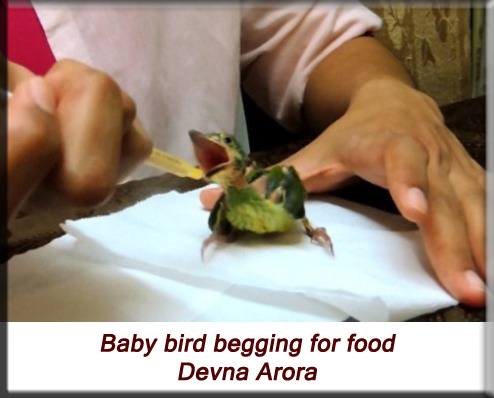
The chicks gape as soon as the feeder approaches them. If not, you may gently tap on the chick’s beak to stimulate begging and feeding. The chicks will only have a couple of morsels at a time. If using a syringe, feed the chicks the equivalent of a couple of bite-sized morsels for that chick. The chick must be given time to swallow the first morsel before the second one is offered. Once it has had enough to eat, the chick will stop gaping and refuse to open its beak. Feeding must be stopped immediately. The baby must not be forced to feed when it is reluctant to accept food. Force feeding or over feeding can cause the formula to flow into the throat and down its windpipe, which can be life threatening. The beak and feathers must be wiped gently with a moist cloth after feeding.
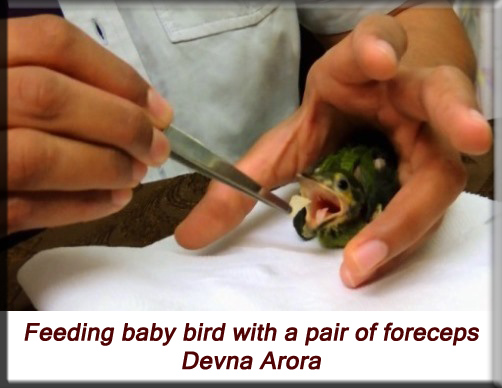
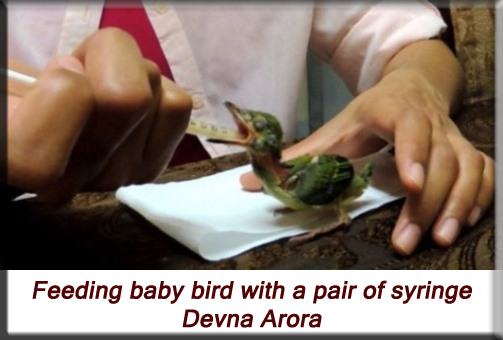
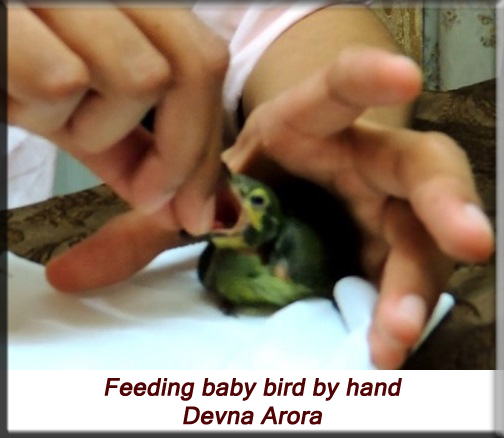
Baby bird droppings
In comparison to their size, baby barbets consume copious amounts of food, which obviously means that there will lots and lots of poop. In my experience, their poop is well clustered and very easy to remove as long as they are getting the right feed. It is often only when feeding is inappropriate that the problems start.
The dropping will of course vary in colour and consistency depending upon the feed given, but here are some examples of healthy and normal droppings of baby barbets. Anything pasty or watery is definitely not a good sign and the diet must be rectified immediately.
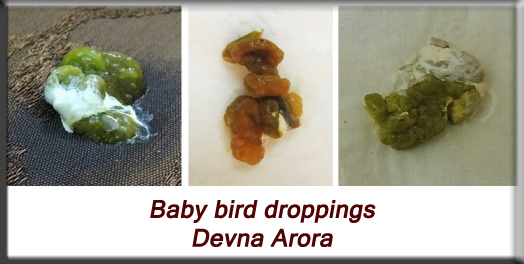
Drinking water
Although most barbets would prefer to suck the water droplets on wet foliage, which is a typical behaviour of all highly arboreal species, they will be tempted to descend to water bowls during the peak of the summers. A small bowl of fresh water must therefore always be available for the barbets.
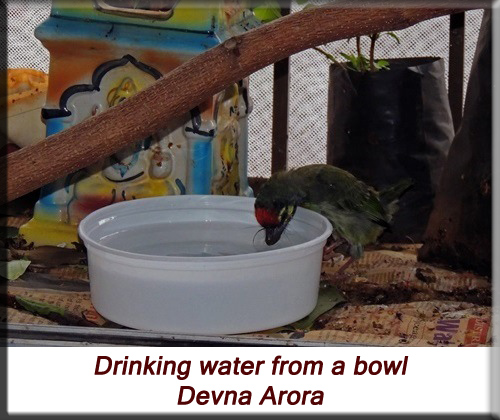
Bathing
Barbets seldom bathe in water bowls. They are arboreal birds and prefer to stay in tree cover. What they do enjoy is playing in foliage that has been sprayed with water – they will roll in the leaves and get as much water on themselves as they can. Encourage this behaviour by spraying the foliage in their enclosure once every day in the afternoons – this also helps to beat the summer heat. You may also gently spray them with a plant mister once in a few days – this also encourages preening as they preen more actively once they are a little soggy. A fresh bowl of drinking water must always be available for the birds nonetheless.
Continue to Page 2: growth and corresponding care
Please note: This document is targeted at hand-rearing alone and does not address or substitute any veterinary procedures. For any medical concerns, please consult your veterinarian at the earliest.
For amateurs or people handling new born chicks for the very first time, please keep in touch with a trained and experienced hand for guidance and regular progress updates.
Protocol published in 2013





